Human Behaviour in Organisation: Motivational Approaches and Leadership Theories in Starbucks
VerifiedAdded on 2023/06/03
|12
|3998
|469
AI Summary
This essay discusses the significance of motivational approaches and leadership theories in an organisation, with a focus on Howard Schultz's approach in Starbucks. It also compares and contrasts the motivational theories of Maslow, Herzberg, and Adams. The implementation of these theories in Starbucks is also discussed.
Contribute Materials
Your contribution can guide someone’s learning journey. Share your
documents today.
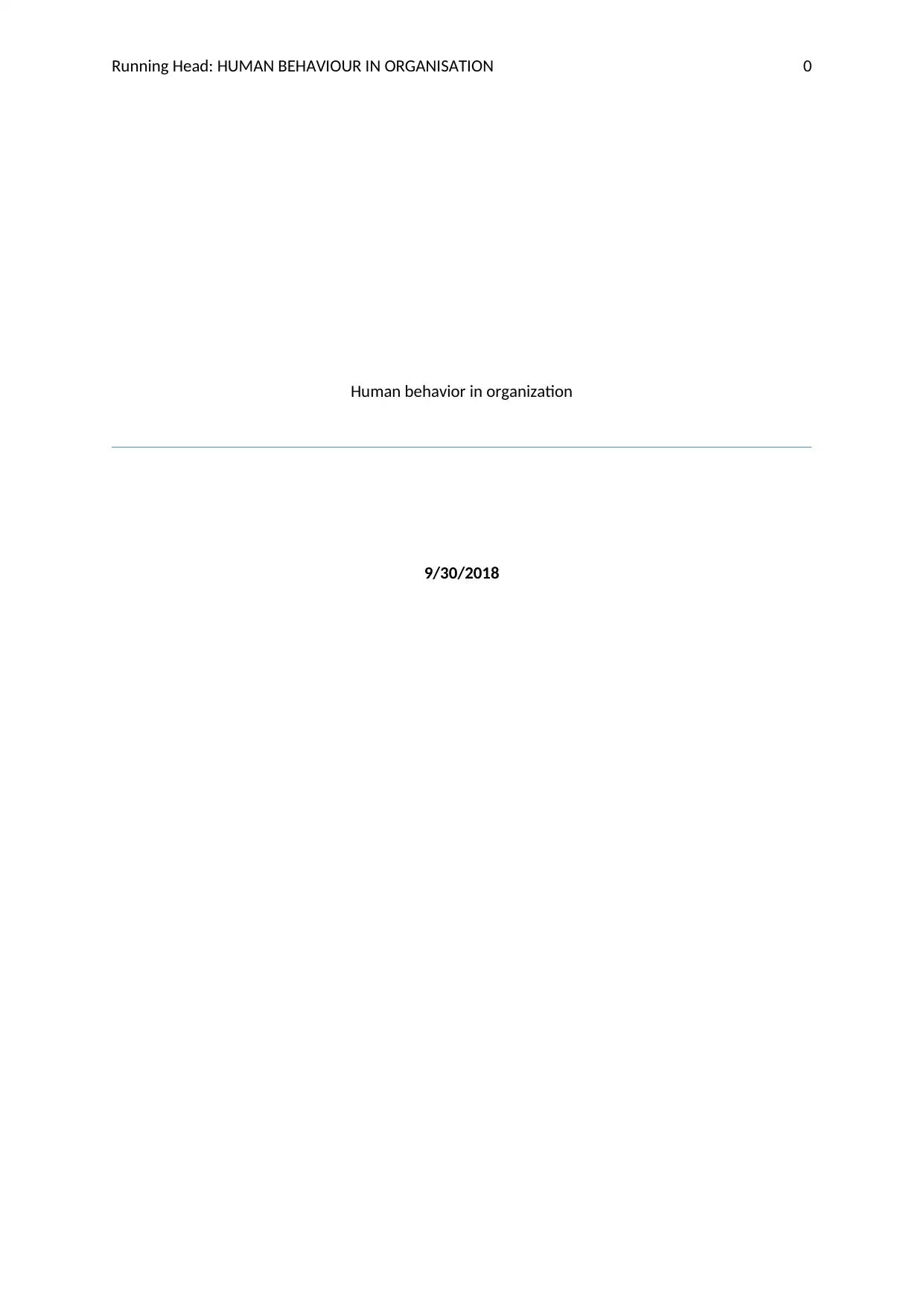
Running Head: HUMAN BEHAVIOUR IN ORGANISATION 0
Human behavior in organization
9/30/2018
Human behavior in organization
9/30/2018
Secure Best Marks with AI Grader
Need help grading? Try our AI Grader for instant feedback on your assignments.
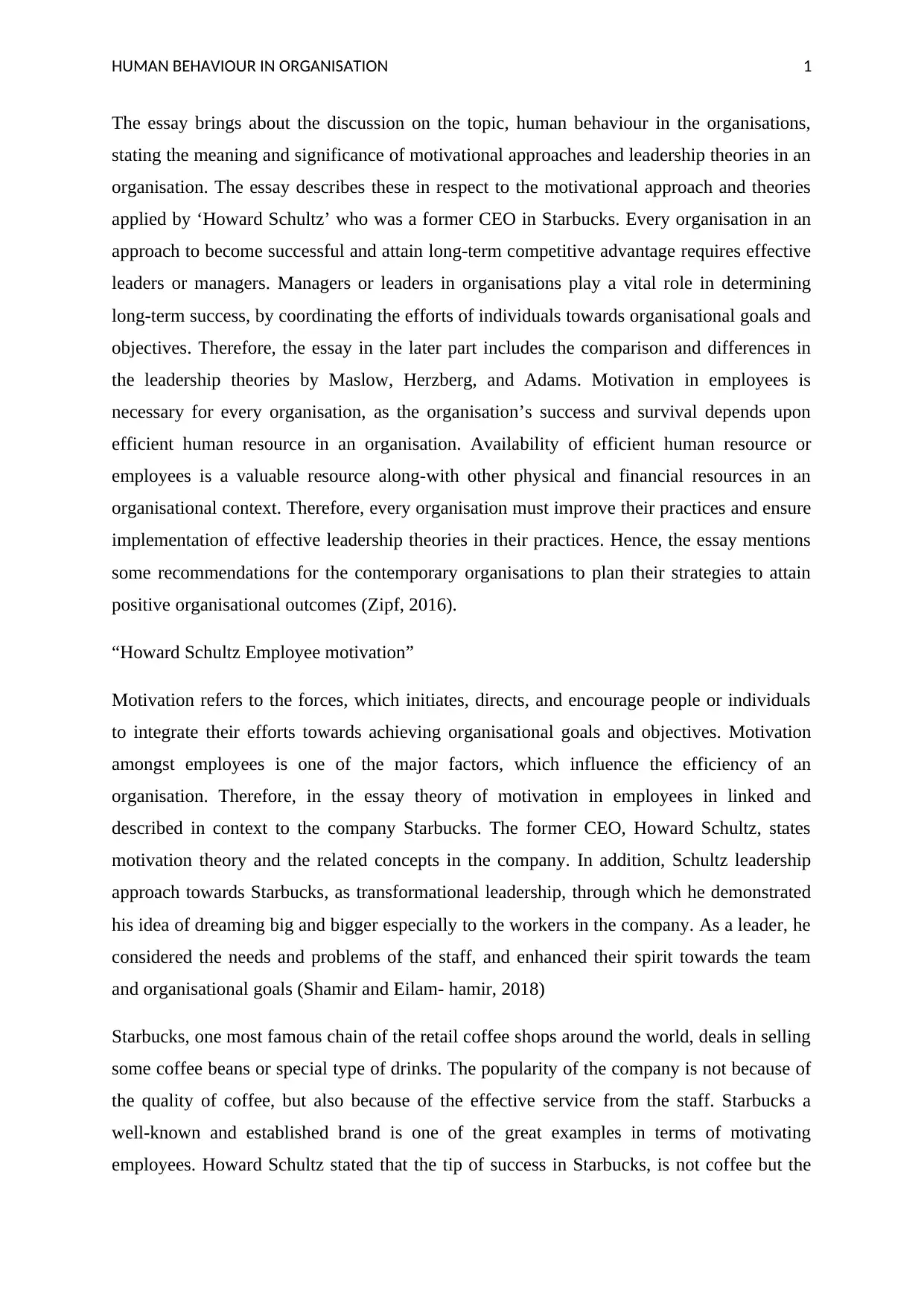
HUMAN BEHAVIOUR IN ORGANISATION 1
The essay brings about the discussion on the topic, human behaviour in the organisations,
stating the meaning and significance of motivational approaches and leadership theories in an
organisation. The essay describes these in respect to the motivational approach and theories
applied by ‘Howard Schultz’ who was a former CEO in Starbucks. Every organisation in an
approach to become successful and attain long-term competitive advantage requires effective
leaders or managers. Managers or leaders in organisations play a vital role in determining
long-term success, by coordinating the efforts of individuals towards organisational goals and
objectives. Therefore, the essay in the later part includes the comparison and differences in
the leadership theories by Maslow, Herzberg, and Adams. Motivation in employees is
necessary for every organisation, as the organisation’s success and survival depends upon
efficient human resource in an organisation. Availability of efficient human resource or
employees is a valuable resource along-with other physical and financial resources in an
organisational context. Therefore, every organisation must improve their practices and ensure
implementation of effective leadership theories in their practices. Hence, the essay mentions
some recommendations for the contemporary organisations to plan their strategies to attain
positive organisational outcomes (Zipf, 2016).
“Howard Schultz Employee motivation”
Motivation refers to the forces, which initiates, directs, and encourage people or individuals
to integrate their efforts towards achieving organisational goals and objectives. Motivation
amongst employees is one of the major factors, which influence the efficiency of an
organisation. Therefore, in the essay theory of motivation in employees in linked and
described in context to the company Starbucks. The former CEO, Howard Schultz, states
motivation theory and the related concepts in the company. In addition, Schultz leadership
approach towards Starbucks, as transformational leadership, through which he demonstrated
his idea of dreaming big and bigger especially to the workers in the company. As a leader, he
considered the needs and problems of the staff, and enhanced their spirit towards the team
and organisational goals (Shamir and Eilam- hamir, 2018)
Starbucks, one most famous chain of the retail coffee shops around the world, deals in selling
some coffee beans or special type of drinks. The popularity of the company is not because of
the quality of coffee, but also because of the effective service from the staff. Starbucks a
well-known and established brand is one of the great examples in terms of motivating
employees. Howard Schultz stated that the tip of success in Starbucks, is not coffee but the
The essay brings about the discussion on the topic, human behaviour in the organisations,
stating the meaning and significance of motivational approaches and leadership theories in an
organisation. The essay describes these in respect to the motivational approach and theories
applied by ‘Howard Schultz’ who was a former CEO in Starbucks. Every organisation in an
approach to become successful and attain long-term competitive advantage requires effective
leaders or managers. Managers or leaders in organisations play a vital role in determining
long-term success, by coordinating the efforts of individuals towards organisational goals and
objectives. Therefore, the essay in the later part includes the comparison and differences in
the leadership theories by Maslow, Herzberg, and Adams. Motivation in employees is
necessary for every organisation, as the organisation’s success and survival depends upon
efficient human resource in an organisation. Availability of efficient human resource or
employees is a valuable resource along-with other physical and financial resources in an
organisational context. Therefore, every organisation must improve their practices and ensure
implementation of effective leadership theories in their practices. Hence, the essay mentions
some recommendations for the contemporary organisations to plan their strategies to attain
positive organisational outcomes (Zipf, 2016).
“Howard Schultz Employee motivation”
Motivation refers to the forces, which initiates, directs, and encourage people or individuals
to integrate their efforts towards achieving organisational goals and objectives. Motivation
amongst employees is one of the major factors, which influence the efficiency of an
organisation. Therefore, in the essay theory of motivation in employees in linked and
described in context to the company Starbucks. The former CEO, Howard Schultz, states
motivation theory and the related concepts in the company. In addition, Schultz leadership
approach towards Starbucks, as transformational leadership, through which he demonstrated
his idea of dreaming big and bigger especially to the workers in the company. As a leader, he
considered the needs and problems of the staff, and enhanced their spirit towards the team
and organisational goals (Shamir and Eilam- hamir, 2018)
Starbucks, one most famous chain of the retail coffee shops around the world, deals in selling
some coffee beans or special type of drinks. The popularity of the company is not because of
the quality of coffee, but also because of the effective service from the staff. Starbucks a
well-known and established brand is one of the great examples in terms of motivating
employees. Howard Schultz stated that the tip of success in Starbucks, is not coffee but the
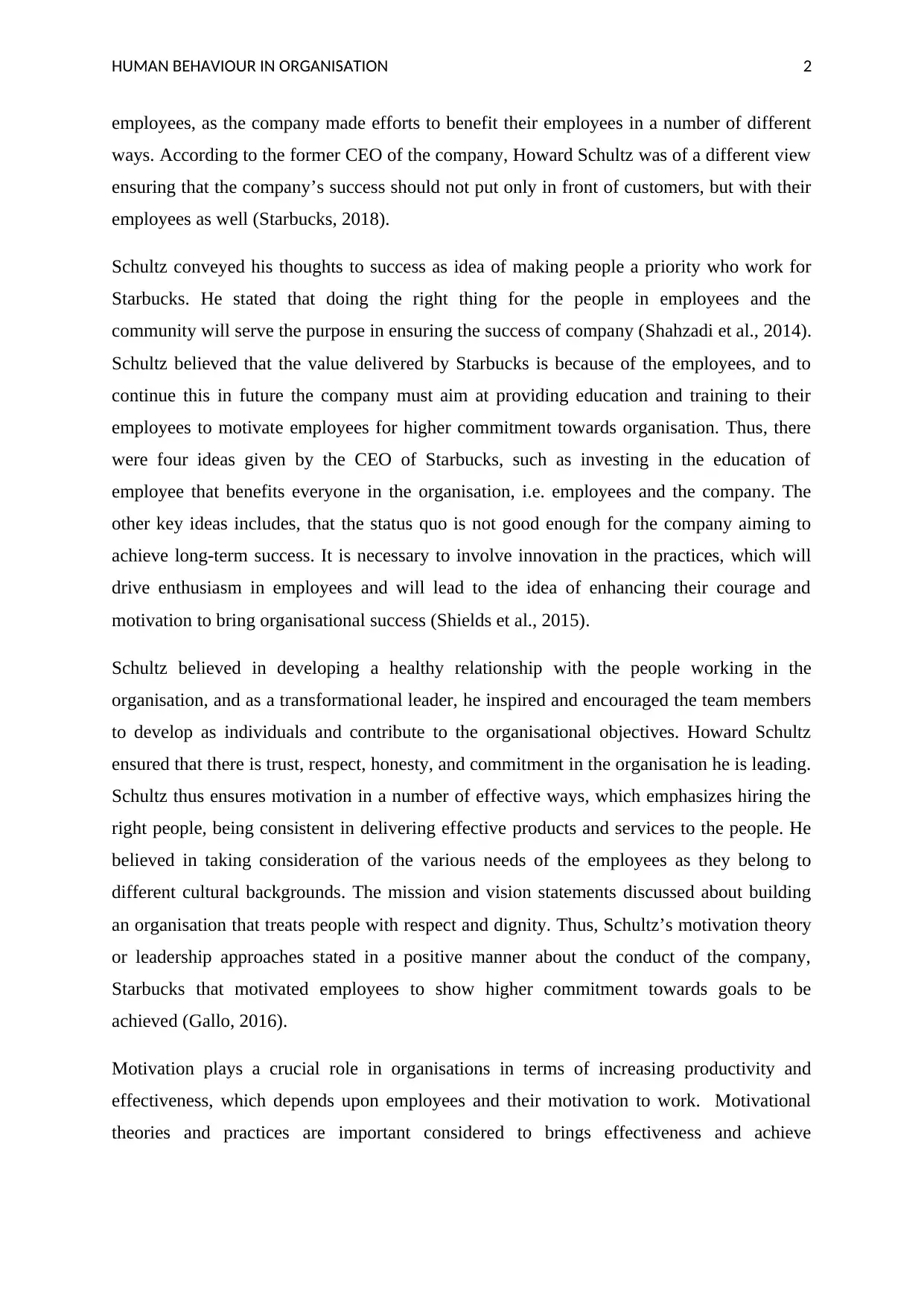
HUMAN BEHAVIOUR IN ORGANISATION 2
employees, as the company made efforts to benefit their employees in a number of different
ways. According to the former CEO of the company, Howard Schultz was of a different view
ensuring that the company’s success should not put only in front of customers, but with their
employees as well (Starbucks, 2018).
Schultz conveyed his thoughts to success as idea of making people a priority who work for
Starbucks. He stated that doing the right thing for the people in employees and the
community will serve the purpose in ensuring the success of company (Shahzadi et al., 2014).
Schultz believed that the value delivered by Starbucks is because of the employees, and to
continue this in future the company must aim at providing education and training to their
employees to motivate employees for higher commitment towards organisation. Thus, there
were four ideas given by the CEO of Starbucks, such as investing in the education of
employee that benefits everyone in the organisation, i.e. employees and the company. The
other key ideas includes, that the status quo is not good enough for the company aiming to
achieve long-term success. It is necessary to involve innovation in the practices, which will
drive enthusiasm in employees and will lead to the idea of enhancing their courage and
motivation to bring organisational success (Shields et al., 2015).
Schultz believed in developing a healthy relationship with the people working in the
organisation, and as a transformational leader, he inspired and encouraged the team members
to develop as individuals and contribute to the organisational objectives. Howard Schultz
ensured that there is trust, respect, honesty, and commitment in the organisation he is leading.
Schultz thus ensures motivation in a number of effective ways, which emphasizes hiring the
right people, being consistent in delivering effective products and services to the people. He
believed in taking consideration of the various needs of the employees as they belong to
different cultural backgrounds. The mission and vision statements discussed about building
an organisation that treats people with respect and dignity. Thus, Schultz’s motivation theory
or leadership approaches stated in a positive manner about the conduct of the company,
Starbucks that motivated employees to show higher commitment towards goals to be
achieved (Gallo, 2016).
Motivation plays a crucial role in organisations in terms of increasing productivity and
effectiveness, which depends upon employees and their motivation to work. Motivational
theories and practices are important considered to brings effectiveness and achieve
employees, as the company made efforts to benefit their employees in a number of different
ways. According to the former CEO of the company, Howard Schultz was of a different view
ensuring that the company’s success should not put only in front of customers, but with their
employees as well (Starbucks, 2018).
Schultz conveyed his thoughts to success as idea of making people a priority who work for
Starbucks. He stated that doing the right thing for the people in employees and the
community will serve the purpose in ensuring the success of company (Shahzadi et al., 2014).
Schultz believed that the value delivered by Starbucks is because of the employees, and to
continue this in future the company must aim at providing education and training to their
employees to motivate employees for higher commitment towards organisation. Thus, there
were four ideas given by the CEO of Starbucks, such as investing in the education of
employee that benefits everyone in the organisation, i.e. employees and the company. The
other key ideas includes, that the status quo is not good enough for the company aiming to
achieve long-term success. It is necessary to involve innovation in the practices, which will
drive enthusiasm in employees and will lead to the idea of enhancing their courage and
motivation to bring organisational success (Shields et al., 2015).
Schultz believed in developing a healthy relationship with the people working in the
organisation, and as a transformational leader, he inspired and encouraged the team members
to develop as individuals and contribute to the organisational objectives. Howard Schultz
ensured that there is trust, respect, honesty, and commitment in the organisation he is leading.
Schultz thus ensures motivation in a number of effective ways, which emphasizes hiring the
right people, being consistent in delivering effective products and services to the people. He
believed in taking consideration of the various needs of the employees as they belong to
different cultural backgrounds. The mission and vision statements discussed about building
an organisation that treats people with respect and dignity. Thus, Schultz’s motivation theory
or leadership approaches stated in a positive manner about the conduct of the company,
Starbucks that motivated employees to show higher commitment towards goals to be
achieved (Gallo, 2016).
Motivation plays a crucial role in organisations in terms of increasing productivity and
effectiveness, which depends upon employees and their motivation to work. Motivational
theories and practices are important considered to brings effectiveness and achieve
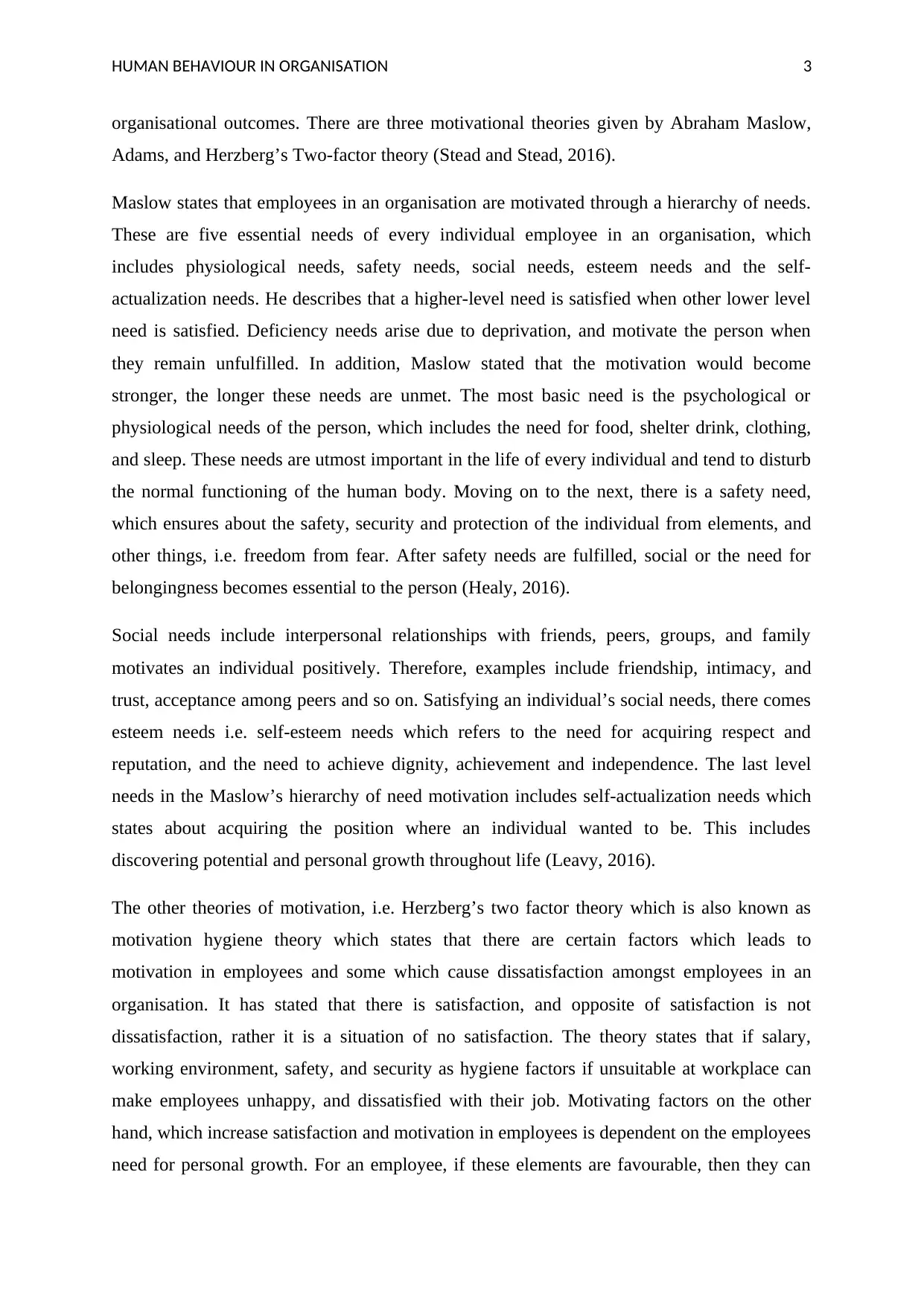
HUMAN BEHAVIOUR IN ORGANISATION 3
organisational outcomes. There are three motivational theories given by Abraham Maslow,
Adams, and Herzberg’s Two-factor theory (Stead and Stead, 2016).
Maslow states that employees in an organisation are motivated through a hierarchy of needs.
These are five essential needs of every individual employee in an organisation, which
includes physiological needs, safety needs, social needs, esteem needs and the self-
actualization needs. He describes that a higher-level need is satisfied when other lower level
need is satisfied. Deficiency needs arise due to deprivation, and motivate the person when
they remain unfulfilled. In addition, Maslow stated that the motivation would become
stronger, the longer these needs are unmet. The most basic need is the psychological or
physiological needs of the person, which includes the need for food, shelter drink, clothing,
and sleep. These needs are utmost important in the life of every individual and tend to disturb
the normal functioning of the human body. Moving on to the next, there is a safety need,
which ensures about the safety, security and protection of the individual from elements, and
other things, i.e. freedom from fear. After safety needs are fulfilled, social or the need for
belongingness becomes essential to the person (Healy, 2016).
Social needs include interpersonal relationships with friends, peers, groups, and family
motivates an individual positively. Therefore, examples include friendship, intimacy, and
trust, acceptance among peers and so on. Satisfying an individual’s social needs, there comes
esteem needs i.e. self-esteem needs which refers to the need for acquiring respect and
reputation, and the need to achieve dignity, achievement and independence. The last level
needs in the Maslow’s hierarchy of need motivation includes self-actualization needs which
states about acquiring the position where an individual wanted to be. This includes
discovering potential and personal growth throughout life (Leavy, 2016).
The other theories of motivation, i.e. Herzberg’s two factor theory which is also known as
motivation hygiene theory which states that there are certain factors which leads to
motivation in employees and some which cause dissatisfaction amongst employees in an
organisation. It has stated that there is satisfaction, and opposite of satisfaction is not
dissatisfaction, rather it is a situation of no satisfaction. The theory states that if salary,
working environment, safety, and security as hygiene factors if unsuitable at workplace can
make employees unhappy, and dissatisfied with their job. Motivating factors on the other
hand, which increase satisfaction and motivation in employees is dependent on the employees
need for personal growth. For an employee, if these elements are favourable, then they can
organisational outcomes. There are three motivational theories given by Abraham Maslow,
Adams, and Herzberg’s Two-factor theory (Stead and Stead, 2016).
Maslow states that employees in an organisation are motivated through a hierarchy of needs.
These are five essential needs of every individual employee in an organisation, which
includes physiological needs, safety needs, social needs, esteem needs and the self-
actualization needs. He describes that a higher-level need is satisfied when other lower level
need is satisfied. Deficiency needs arise due to deprivation, and motivate the person when
they remain unfulfilled. In addition, Maslow stated that the motivation would become
stronger, the longer these needs are unmet. The most basic need is the psychological or
physiological needs of the person, which includes the need for food, shelter drink, clothing,
and sleep. These needs are utmost important in the life of every individual and tend to disturb
the normal functioning of the human body. Moving on to the next, there is a safety need,
which ensures about the safety, security and protection of the individual from elements, and
other things, i.e. freedom from fear. After safety needs are fulfilled, social or the need for
belongingness becomes essential to the person (Healy, 2016).
Social needs include interpersonal relationships with friends, peers, groups, and family
motivates an individual positively. Therefore, examples include friendship, intimacy, and
trust, acceptance among peers and so on. Satisfying an individual’s social needs, there comes
esteem needs i.e. self-esteem needs which refers to the need for acquiring respect and
reputation, and the need to achieve dignity, achievement and independence. The last level
needs in the Maslow’s hierarchy of need motivation includes self-actualization needs which
states about acquiring the position where an individual wanted to be. This includes
discovering potential and personal growth throughout life (Leavy, 2016).
The other theories of motivation, i.e. Herzberg’s two factor theory which is also known as
motivation hygiene theory which states that there are certain factors which leads to
motivation in employees and some which cause dissatisfaction amongst employees in an
organisation. It has stated that there is satisfaction, and opposite of satisfaction is not
dissatisfaction, rather it is a situation of no satisfaction. The theory states that if salary,
working environment, safety, and security as hygiene factors if unsuitable at workplace can
make employees unhappy, and dissatisfied with their job. Motivating factors on the other
hand, which increase satisfaction and motivation in employees is dependent on the employees
need for personal growth. For an employee, if these elements are favourable, then they can
Secure Best Marks with AI Grader
Need help grading? Try our AI Grader for instant feedback on your assignments.

HUMAN BEHAVIOUR IN ORGANISATION 4
motivate and help an employee to achieve performance above average levels. For an instance,
an employee with responsibility and achievement can cause satisfaction and motivate him for
better performance (Sanjeev and Surya, 2016).
Factors of Job-satisfaction (Motivating
factors)
Factors of job-dissatisfaction (Hygiene
factors)
Achievement Supervision
Recognition Company policy and administration
Responsibility Salary
Work itself Interpersonal relationship
Advancement Working conditions
The above table explains the five factors of motivation, which includes both motivating
factors and hygiene factors, leading to satisfaction and dissatisfaction of employees in an
organisational context. Therefore comparing both the theories of Maslow and Herzberg
motivation stated that salary in case of Herzberg not treated as motivator just like the other
primary motivators (achievement and recognition). He stated that one can always get higher
and higher salary, then it can motivate the person, cannot be considered as incentive. This is
not applicable according to the perspective of Maslow, as he described salary or money as
motivator, because one need money or salary in order to buy food to eat, to have shelter, to
shop , i.e. it acts as one of the psychological needs of the person (Stoyanov, 2017).
Adam’s equity theory is the last theory described in this essay, the equity theory of
motivation states that people in an organisation can be motivated if they are given equal
treatment and receive fair for their efforts by their supervisors. The theory by Adams (1965)
is based on social exchange theory, in that people compare their contribution to work, cost of
their actions, and put inputs into the job and expect some positive outputs/outcomes. These
inputs include education, experience, and efforts, to get some output such as salary, reward,
promotion, verbal recognition, and challenges in equal amount. Therefore, equity plays an
important role in affecting the productivity of an employee, as greater the inequity, the
greater the distress amongst individuals. The major difference or limitation in this theory is
that equity theory does not consider the variation in needs, interest, and values of people in
organisation. Equity for one may not be for other; therefore ensuring equity to all individuals
is essential to motivation. In accordance to theory, equity structure in the workplace is based
motivate and help an employee to achieve performance above average levels. For an instance,
an employee with responsibility and achievement can cause satisfaction and motivate him for
better performance (Sanjeev and Surya, 2016).
Factors of Job-satisfaction (Motivating
factors)
Factors of job-dissatisfaction (Hygiene
factors)
Achievement Supervision
Recognition Company policy and administration
Responsibility Salary
Work itself Interpersonal relationship
Advancement Working conditions
The above table explains the five factors of motivation, which includes both motivating
factors and hygiene factors, leading to satisfaction and dissatisfaction of employees in an
organisational context. Therefore comparing both the theories of Maslow and Herzberg
motivation stated that salary in case of Herzberg not treated as motivator just like the other
primary motivators (achievement and recognition). He stated that one can always get higher
and higher salary, then it can motivate the person, cannot be considered as incentive. This is
not applicable according to the perspective of Maslow, as he described salary or money as
motivator, because one need money or salary in order to buy food to eat, to have shelter, to
shop , i.e. it acts as one of the psychological needs of the person (Stoyanov, 2017).
Adam’s equity theory is the last theory described in this essay, the equity theory of
motivation states that people in an organisation can be motivated if they are given equal
treatment and receive fair for their efforts by their supervisors. The theory by Adams (1965)
is based on social exchange theory, in that people compare their contribution to work, cost of
their actions, and put inputs into the job and expect some positive outputs/outcomes. These
inputs include education, experience, and efforts, to get some output such as salary, reward,
promotion, verbal recognition, and challenges in equal amount. Therefore, equity plays an
important role in affecting the productivity of an employee, as greater the inequity, the
greater the distress amongst individuals. The major difference or limitation in this theory is
that equity theory does not consider the variation in needs, interest, and values of people in
organisation. Equity for one may not be for other; therefore ensuring equity to all individuals
is essential to motivation. In accordance to theory, equity structure in the workplace is based
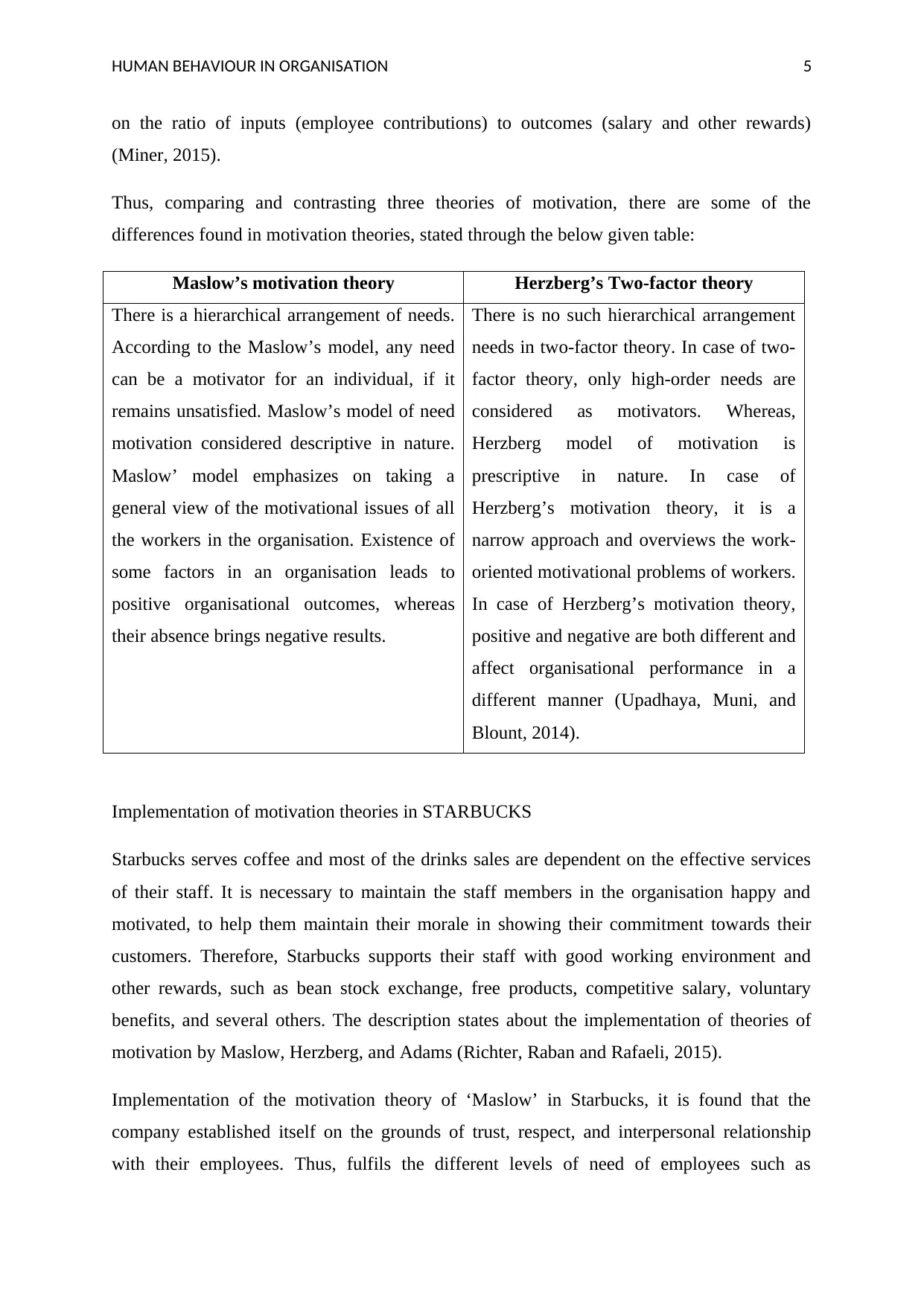
HUMAN BEHAVIOUR IN ORGANISATION 5
on the ratio of inputs (employee contributions) to outcomes (salary and other rewards)
(Miner, 2015).
Thus, comparing and contrasting three theories of motivation, there are some of the
differences found in motivation theories, stated through the below given table:
Maslow’s motivation theory Herzberg’s Two-factor theory
There is a hierarchical arrangement of needs.
According to the Maslow’s model, any need
can be a motivator for an individual, if it
remains unsatisfied. Maslow’s model of need
motivation considered descriptive in nature.
Maslow’ model emphasizes on taking a
general view of the motivational issues of all
the workers in the organisation. Existence of
some factors in an organisation leads to
positive organisational outcomes, whereas
their absence brings negative results.
There is no such hierarchical arrangement
needs in two-factor theory. In case of two-
factor theory, only high-order needs are
considered as motivators. Whereas,
Herzberg model of motivation is
prescriptive in nature. In case of
Herzberg’s motivation theory, it is a
narrow approach and overviews the work-
oriented motivational problems of workers.
In case of Herzberg’s motivation theory,
positive and negative are both different and
affect organisational performance in a
different manner (Upadhaya, Muni, and
Blount, 2014).
Implementation of motivation theories in STARBUCKS
Starbucks serves coffee and most of the drinks sales are dependent on the effective services
of their staff. It is necessary to maintain the staff members in the organisation happy and
motivated, to help them maintain their morale in showing their commitment towards their
customers. Therefore, Starbucks supports their staff with good working environment and
other rewards, such as bean stock exchange, free products, competitive salary, voluntary
benefits, and several others. The description states about the implementation of theories of
motivation by Maslow, Herzberg, and Adams (Richter, Raban and Rafaeli, 2015).
Implementation of the motivation theory of ‘Maslow’ in Starbucks, it is found that the
company established itself on the grounds of trust, respect, and interpersonal relationship
with their employees. Thus, fulfils the different levels of need of employees such as
on the ratio of inputs (employee contributions) to outcomes (salary and other rewards)
(Miner, 2015).
Thus, comparing and contrasting three theories of motivation, there are some of the
differences found in motivation theories, stated through the below given table:
Maslow’s motivation theory Herzberg’s Two-factor theory
There is a hierarchical arrangement of needs.
According to the Maslow’s model, any need
can be a motivator for an individual, if it
remains unsatisfied. Maslow’s model of need
motivation considered descriptive in nature.
Maslow’ model emphasizes on taking a
general view of the motivational issues of all
the workers in the organisation. Existence of
some factors in an organisation leads to
positive organisational outcomes, whereas
their absence brings negative results.
There is no such hierarchical arrangement
needs in two-factor theory. In case of two-
factor theory, only high-order needs are
considered as motivators. Whereas,
Herzberg model of motivation is
prescriptive in nature. In case of
Herzberg’s motivation theory, it is a
narrow approach and overviews the work-
oriented motivational problems of workers.
In case of Herzberg’s motivation theory,
positive and negative are both different and
affect organisational performance in a
different manner (Upadhaya, Muni, and
Blount, 2014).
Implementation of motivation theories in STARBUCKS
Starbucks serves coffee and most of the drinks sales are dependent on the effective services
of their staff. It is necessary to maintain the staff members in the organisation happy and
motivated, to help them maintain their morale in showing their commitment towards their
customers. Therefore, Starbucks supports their staff with good working environment and
other rewards, such as bean stock exchange, free products, competitive salary, voluntary
benefits, and several others. The description states about the implementation of theories of
motivation by Maslow, Herzberg, and Adams (Richter, Raban and Rafaeli, 2015).
Implementation of the motivation theory of ‘Maslow’ in Starbucks, it is found that the
company established itself on the grounds of trust, respect, and interpersonal relationship
with their employees. Thus, fulfils the different levels of need of employees such as
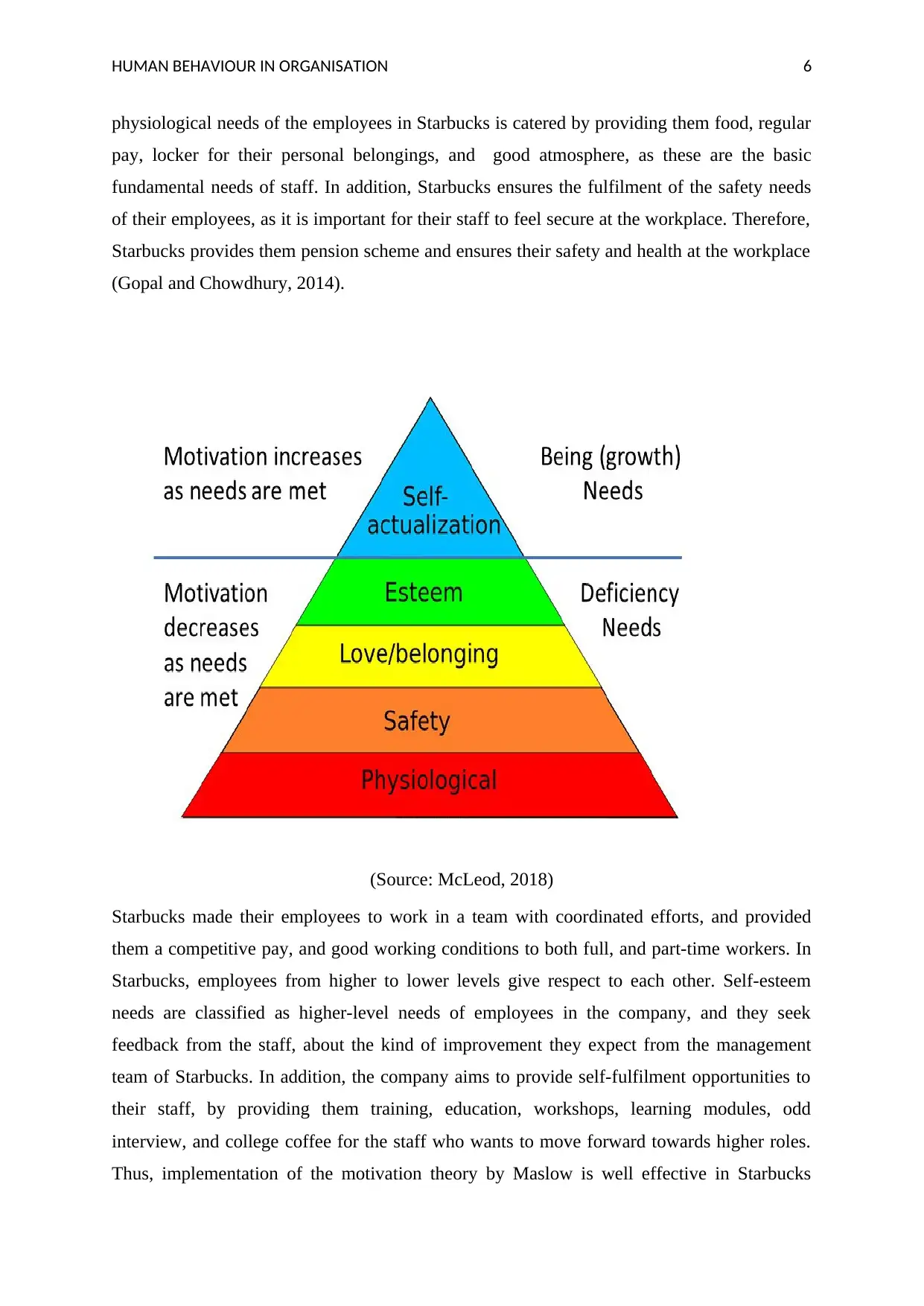
HUMAN BEHAVIOUR IN ORGANISATION 6
physiological needs of the employees in Starbucks is catered by providing them food, regular
pay, locker for their personal belongings, and good atmosphere, as these are the basic
fundamental needs of staff. In addition, Starbucks ensures the fulfilment of the safety needs
of their employees, as it is important for their staff to feel secure at the workplace. Therefore,
Starbucks provides them pension scheme and ensures their safety and health at the workplace
(Gopal and Chowdhury, 2014).
(Source: McLeod, 2018)
Starbucks made their employees to work in a team with coordinated efforts, and provided
them a competitive pay, and good working conditions to both full, and part-time workers. In
Starbucks, employees from higher to lower levels give respect to each other. Self-esteem
needs are classified as higher-level needs of employees in the company, and they seek
feedback from the staff, about the kind of improvement they expect from the management
team of Starbucks. In addition, the company aims to provide self-fulfilment opportunities to
their staff, by providing them training, education, workshops, learning modules, odd
interview, and college coffee for the staff who wants to move forward towards higher roles.
Thus, implementation of the motivation theory by Maslow is well effective in Starbucks
physiological needs of the employees in Starbucks is catered by providing them food, regular
pay, locker for their personal belongings, and good atmosphere, as these are the basic
fundamental needs of staff. In addition, Starbucks ensures the fulfilment of the safety needs
of their employees, as it is important for their staff to feel secure at the workplace. Therefore,
Starbucks provides them pension scheme and ensures their safety and health at the workplace
(Gopal and Chowdhury, 2014).
(Source: McLeod, 2018)
Starbucks made their employees to work in a team with coordinated efforts, and provided
them a competitive pay, and good working conditions to both full, and part-time workers. In
Starbucks, employees from higher to lower levels give respect to each other. Self-esteem
needs are classified as higher-level needs of employees in the company, and they seek
feedback from the staff, about the kind of improvement they expect from the management
team of Starbucks. In addition, the company aims to provide self-fulfilment opportunities to
their staff, by providing them training, education, workshops, learning modules, odd
interview, and college coffee for the staff who wants to move forward towards higher roles.
Thus, implementation of the motivation theory by Maslow is well effective in Starbucks
Paraphrase This Document
Need a fresh take? Get an instant paraphrase of this document with our AI Paraphraser
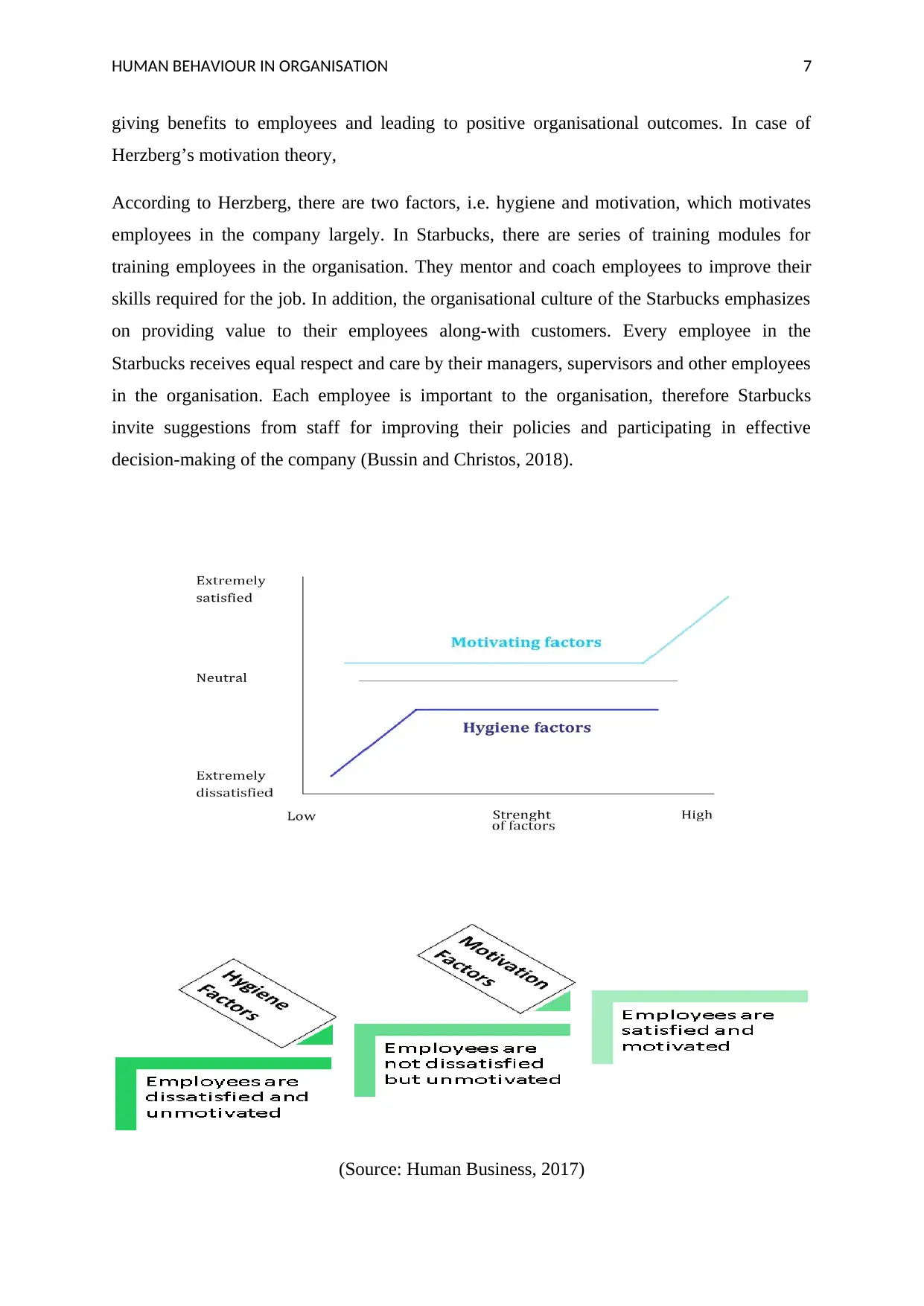
HUMAN BEHAVIOUR IN ORGANISATION 7
giving benefits to employees and leading to positive organisational outcomes. In case of
Herzberg’s motivation theory,
According to Herzberg, there are two factors, i.e. hygiene and motivation, which motivates
employees in the company largely. In Starbucks, there are series of training modules for
training employees in the organisation. They mentor and coach employees to improve their
skills required for the job. In addition, the organisational culture of the Starbucks emphasizes
on providing value to their employees along-with customers. Every employee in the
Starbucks receives equal respect and care by their managers, supervisors and other employees
in the organisation. Each employee is important to the organisation, therefore Starbucks
invite suggestions from staff for improving their policies and participating in effective
decision-making of the company (Bussin and Christos, 2018).
(Source: Human Business, 2017)
giving benefits to employees and leading to positive organisational outcomes. In case of
Herzberg’s motivation theory,
According to Herzberg, there are two factors, i.e. hygiene and motivation, which motivates
employees in the company largely. In Starbucks, there are series of training modules for
training employees in the organisation. They mentor and coach employees to improve their
skills required for the job. In addition, the organisational culture of the Starbucks emphasizes
on providing value to their employees along-with customers. Every employee in the
Starbucks receives equal respect and care by their managers, supervisors and other employees
in the organisation. Each employee is important to the organisation, therefore Starbucks
invite suggestions from staff for improving their policies and participating in effective
decision-making of the company (Bussin and Christos, 2018).
(Source: Human Business, 2017)
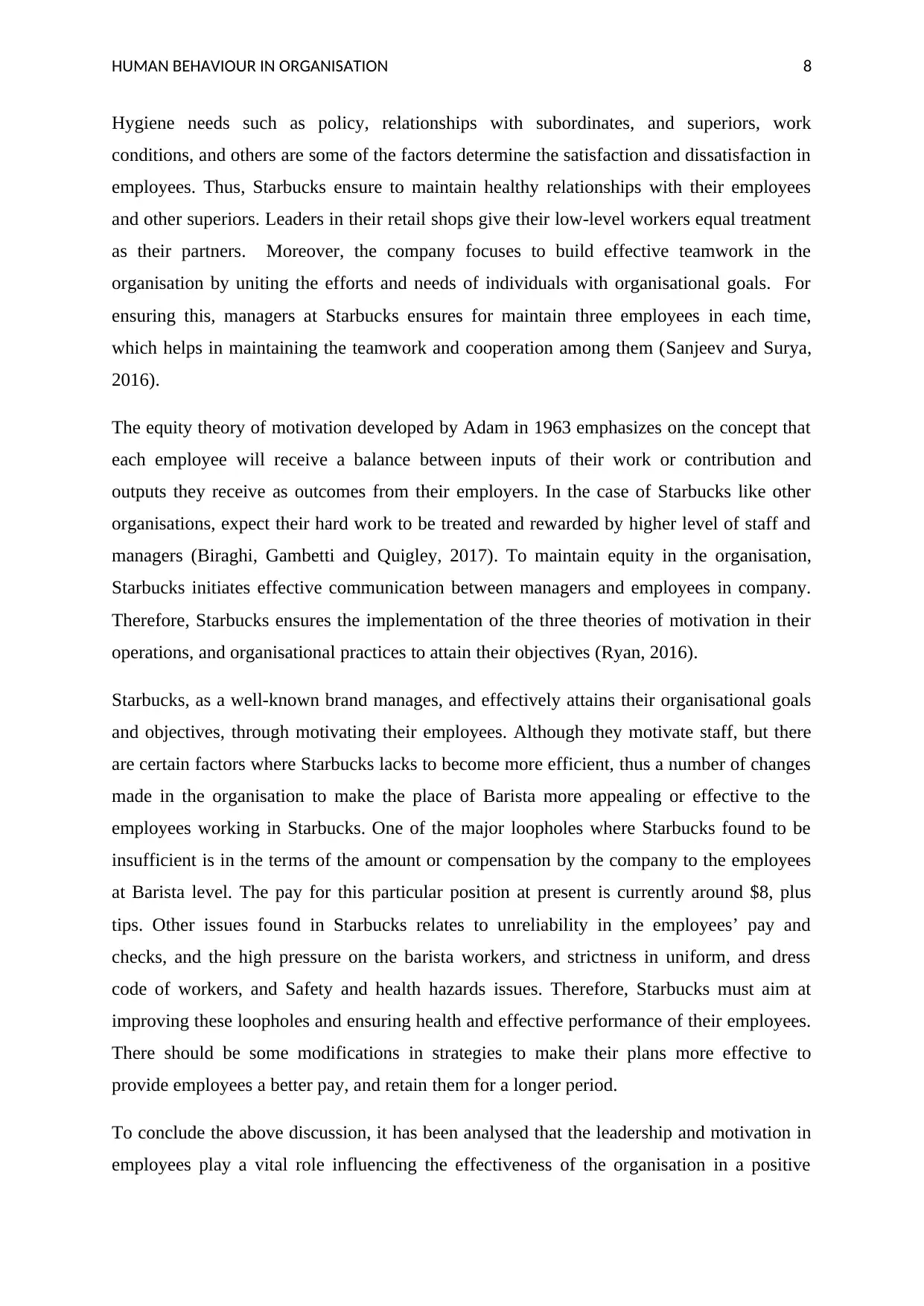
HUMAN BEHAVIOUR IN ORGANISATION 8
Hygiene needs such as policy, relationships with subordinates, and superiors, work
conditions, and others are some of the factors determine the satisfaction and dissatisfaction in
employees. Thus, Starbucks ensure to maintain healthy relationships with their employees
and other superiors. Leaders in their retail shops give their low-level workers equal treatment
as their partners. Moreover, the company focuses to build effective teamwork in the
organisation by uniting the efforts and needs of individuals with organisational goals. For
ensuring this, managers at Starbucks ensures for maintain three employees in each time,
which helps in maintaining the teamwork and cooperation among them (Sanjeev and Surya,
2016).
The equity theory of motivation developed by Adam in 1963 emphasizes on the concept that
each employee will receive a balance between inputs of their work or contribution and
outputs they receive as outcomes from their employers. In the case of Starbucks like other
organisations, expect their hard work to be treated and rewarded by higher level of staff and
managers (Biraghi, Gambetti and Quigley, 2017). To maintain equity in the organisation,
Starbucks initiates effective communication between managers and employees in company.
Therefore, Starbucks ensures the implementation of the three theories of motivation in their
operations, and organisational practices to attain their objectives (Ryan, 2016).
Starbucks, as a well-known brand manages, and effectively attains their organisational goals
and objectives, through motivating their employees. Although they motivate staff, but there
are certain factors where Starbucks lacks to become more efficient, thus a number of changes
made in the organisation to make the place of Barista more appealing or effective to the
employees working in Starbucks. One of the major loopholes where Starbucks found to be
insufficient is in the terms of the amount or compensation by the company to the employees
at Barista level. The pay for this particular position at present is currently around $8, plus
tips. Other issues found in Starbucks relates to unreliability in the employees’ pay and
checks, and the high pressure on the barista workers, and strictness in uniform, and dress
code of workers, and Safety and health hazards issues. Therefore, Starbucks must aim at
improving these loopholes and ensuring health and effective performance of their employees.
There should be some modifications in strategies to make their plans more effective to
provide employees a better pay, and retain them for a longer period.
To conclude the above discussion, it has been analysed that the leadership and motivation in
employees play a vital role influencing the effectiveness of the organisation in a positive
Hygiene needs such as policy, relationships with subordinates, and superiors, work
conditions, and others are some of the factors determine the satisfaction and dissatisfaction in
employees. Thus, Starbucks ensure to maintain healthy relationships with their employees
and other superiors. Leaders in their retail shops give their low-level workers equal treatment
as their partners. Moreover, the company focuses to build effective teamwork in the
organisation by uniting the efforts and needs of individuals with organisational goals. For
ensuring this, managers at Starbucks ensures for maintain three employees in each time,
which helps in maintaining the teamwork and cooperation among them (Sanjeev and Surya,
2016).
The equity theory of motivation developed by Adam in 1963 emphasizes on the concept that
each employee will receive a balance between inputs of their work or contribution and
outputs they receive as outcomes from their employers. In the case of Starbucks like other
organisations, expect their hard work to be treated and rewarded by higher level of staff and
managers (Biraghi, Gambetti and Quigley, 2017). To maintain equity in the organisation,
Starbucks initiates effective communication between managers and employees in company.
Therefore, Starbucks ensures the implementation of the three theories of motivation in their
operations, and organisational practices to attain their objectives (Ryan, 2016).
Starbucks, as a well-known brand manages, and effectively attains their organisational goals
and objectives, through motivating their employees. Although they motivate staff, but there
are certain factors where Starbucks lacks to become more efficient, thus a number of changes
made in the organisation to make the place of Barista more appealing or effective to the
employees working in Starbucks. One of the major loopholes where Starbucks found to be
insufficient is in the terms of the amount or compensation by the company to the employees
at Barista level. The pay for this particular position at present is currently around $8, plus
tips. Other issues found in Starbucks relates to unreliability in the employees’ pay and
checks, and the high pressure on the barista workers, and strictness in uniform, and dress
code of workers, and Safety and health hazards issues. Therefore, Starbucks must aim at
improving these loopholes and ensuring health and effective performance of their employees.
There should be some modifications in strategies to make their plans more effective to
provide employees a better pay, and retain them for a longer period.
To conclude the above discussion, it has been analysed that the leadership and motivation in
employees play a vital role influencing the effectiveness of the organisation in a positive

HUMAN BEHAVIOUR IN ORGANISATION 9
manner. Howard Schultz was a transformational leader in his approach towards the
organisation, Starbucks. He stated that one should dream big and bigger for himself, others
and family irrespective of the present situation. The essay in the above part described three
motivational theories, given by Maslow, Herzberg, and Adams, which stated about the
various needs of the employees in the organisation, and how they must be catered in order to
motivate them. Employee motivation remains to be a major factor in every organisation, to
attain positive outcomes, and long-term growth in the future. Hence, leaders or managers in
organisations must ensure their employees are well satisfied with the work and motivated to
show higher commitment towards organisation.
manner. Howard Schultz was a transformational leader in his approach towards the
organisation, Starbucks. He stated that one should dream big and bigger for himself, others
and family irrespective of the present situation. The essay in the above part described three
motivational theories, given by Maslow, Herzberg, and Adams, which stated about the
various needs of the employees in the organisation, and how they must be catered in order to
motivate them. Employee motivation remains to be a major factor in every organisation, to
attain positive outcomes, and long-term growth in the future. Hence, leaders or managers in
organisations must ensure their employees are well satisfied with the work and motivated to
show higher commitment towards organisation.
Secure Best Marks with AI Grader
Need help grading? Try our AI Grader for instant feedback on your assignments.
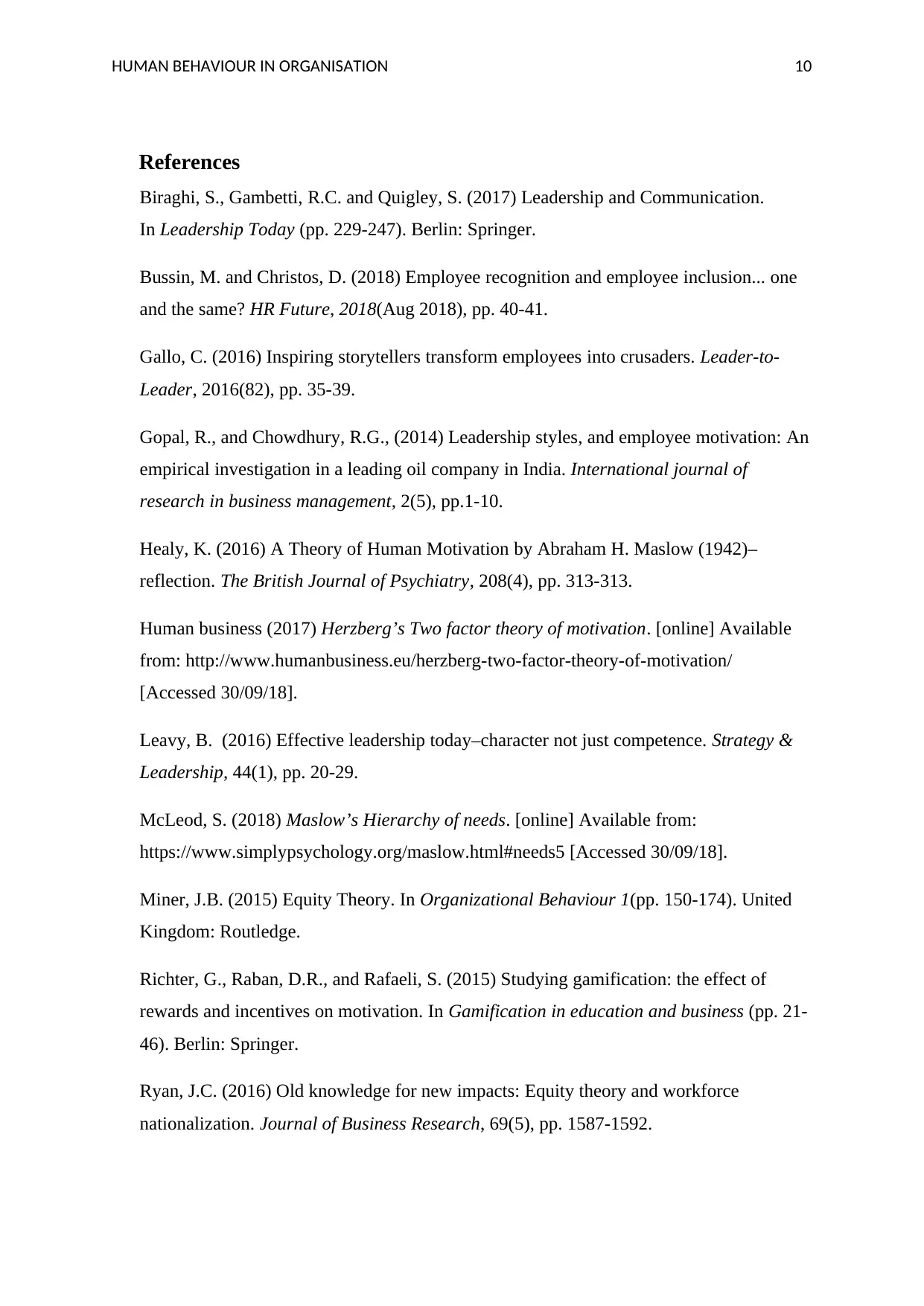
HUMAN BEHAVIOUR IN ORGANISATION 10
References
Biraghi, S., Gambetti, R.C. and Quigley, S. (2017) Leadership and Communication.
In Leadership Today (pp. 229-247). Berlin: Springer.
Bussin, M. and Christos, D. (2018) Employee recognition and employee inclusion... one
and the same? HR Future, 2018(Aug 2018), pp. 40-41.
Gallo, C. (2016) Inspiring storytellers transform employees into crusaders. Leader-to-
Leader, 2016(82), pp. 35-39.
Gopal, R., and Chowdhury, R.G., (2014) Leadership styles, and employee motivation: An
empirical investigation in a leading oil company in India. International journal of
research in business management, 2(5), pp.1-10.
Healy, K. (2016) A Theory of Human Motivation by Abraham H. Maslow (1942)–
reflection. The British Journal of Psychiatry, 208(4), pp. 313-313.
Human business (2017) Herzberg’s Two factor theory of motivation. [online] Available
from: http://www.humanbusiness.eu/herzberg-two-factor-theory-of-motivation/
[Accessed 30/09/18].
Leavy, B. (2016) Effective leadership today–character not just competence. Strategy &
Leadership, 44(1), pp. 20-29.
McLeod, S. (2018) Maslow’s Hierarchy of needs. [online] Available from:
https://www.simplypsychology.org/maslow.html#needs5 [Accessed 30/09/18].
Miner, J.B. (2015) Equity Theory. In Organizational Behaviour 1(pp. 150-174). United
Kingdom: Routledge.
Richter, G., Raban, D.R., and Rafaeli, S. (2015) Studying gamification: the effect of
rewards and incentives on motivation. In Gamification in education and business (pp. 21-
46). Berlin: Springer.
Ryan, J.C. (2016) Old knowledge for new impacts: Equity theory and workforce
nationalization. Journal of Business Research, 69(5), pp. 1587-1592.
References
Biraghi, S., Gambetti, R.C. and Quigley, S. (2017) Leadership and Communication.
In Leadership Today (pp. 229-247). Berlin: Springer.
Bussin, M. and Christos, D. (2018) Employee recognition and employee inclusion... one
and the same? HR Future, 2018(Aug 2018), pp. 40-41.
Gallo, C. (2016) Inspiring storytellers transform employees into crusaders. Leader-to-
Leader, 2016(82), pp. 35-39.
Gopal, R., and Chowdhury, R.G., (2014) Leadership styles, and employee motivation: An
empirical investigation in a leading oil company in India. International journal of
research in business management, 2(5), pp.1-10.
Healy, K. (2016) A Theory of Human Motivation by Abraham H. Maslow (1942)–
reflection. The British Journal of Psychiatry, 208(4), pp. 313-313.
Human business (2017) Herzberg’s Two factor theory of motivation. [online] Available
from: http://www.humanbusiness.eu/herzberg-two-factor-theory-of-motivation/
[Accessed 30/09/18].
Leavy, B. (2016) Effective leadership today–character not just competence. Strategy &
Leadership, 44(1), pp. 20-29.
McLeod, S. (2018) Maslow’s Hierarchy of needs. [online] Available from:
https://www.simplypsychology.org/maslow.html#needs5 [Accessed 30/09/18].
Miner, J.B. (2015) Equity Theory. In Organizational Behaviour 1(pp. 150-174). United
Kingdom: Routledge.
Richter, G., Raban, D.R., and Rafaeli, S. (2015) Studying gamification: the effect of
rewards and incentives on motivation. In Gamification in education and business (pp. 21-
46). Berlin: Springer.
Ryan, J.C. (2016) Old knowledge for new impacts: Equity theory and workforce
nationalization. Journal of Business Research, 69(5), pp. 1587-1592.

HUMAN BEHAVIOUR IN ORGANISATION 11
Sanjeev, M.A., and Surya, A.V. (2016) Two-factor theory of motivation and satisfaction:
an empirical verification. Annals of Data Science, 3(2), pp. 155-173.
Shahzadi, I., Javed, A., Pirzada, S.S., Nasreen, S. and Khanam, F. (2014) Impact of
employee motivation on employee performance. European Journal of Business and
Management, 6(23), pp. 159-166.
Shamir, B. and Eilam-Shamir, G. (2018) “What’s your story?” A life-stories approach to
authentic leadership development. In Leadership Now: Reflections on the Legacy of Boas
Shamir (pp. 51-76). United Kingdom: Emerald Publishing Limited.
Shields, J., Brown, M., Kaine, S., Dolle-Samuel, C., North-Samardzic, A., McLean, P.,
Johns, R., O'Leary, P., Robinson, J., and Plimmer, G. (2015) Managing employee
performance & reward: Concepts, practices, strategies. United Kingdom: Cambridge
University Press.
Starbucks (2018) Starbucks-The Best Coffee and Espresso Drinks. [online] Available
from: https://www.starbucks.com/ [Accessed 30/09/18].
Stead, J.G. and Stead, W.E. (2016) Spiritual capabilities: keys to successful sustainable
strategic management. In Spirituality and Sustainability (pp. 89-103). Berlin: Springer.
Stoyanov, S. (2017) A theory of human motivation. United Kingdom: Macat Library.
Upadhaya, B., Munir, R. and Blount, Y. (2014) Association between performance
measurement systems and organisational effectiveness. International Journal of
Operations & Production Management, 34(7), pp. 853-875.
Zipf, G.K. (2016) Human behaviour and the principle of least effort: An introduction to
human ecology. England: Ravenio Books.
Sanjeev, M.A., and Surya, A.V. (2016) Two-factor theory of motivation and satisfaction:
an empirical verification. Annals of Data Science, 3(2), pp. 155-173.
Shahzadi, I., Javed, A., Pirzada, S.S., Nasreen, S. and Khanam, F. (2014) Impact of
employee motivation on employee performance. European Journal of Business and
Management, 6(23), pp. 159-166.
Shamir, B. and Eilam-Shamir, G. (2018) “What’s your story?” A life-stories approach to
authentic leadership development. In Leadership Now: Reflections on the Legacy of Boas
Shamir (pp. 51-76). United Kingdom: Emerald Publishing Limited.
Shields, J., Brown, M., Kaine, S., Dolle-Samuel, C., North-Samardzic, A., McLean, P.,
Johns, R., O'Leary, P., Robinson, J., and Plimmer, G. (2015) Managing employee
performance & reward: Concepts, practices, strategies. United Kingdom: Cambridge
University Press.
Starbucks (2018) Starbucks-The Best Coffee and Espresso Drinks. [online] Available
from: https://www.starbucks.com/ [Accessed 30/09/18].
Stead, J.G. and Stead, W.E. (2016) Spiritual capabilities: keys to successful sustainable
strategic management. In Spirituality and Sustainability (pp. 89-103). Berlin: Springer.
Stoyanov, S. (2017) A theory of human motivation. United Kingdom: Macat Library.
Upadhaya, B., Munir, R. and Blount, Y. (2014) Association between performance
measurement systems and organisational effectiveness. International Journal of
Operations & Production Management, 34(7), pp. 853-875.
Zipf, G.K. (2016) Human behaviour and the principle of least effort: An introduction to
human ecology. England: Ravenio Books.
1 out of 12
Related Documents
Your All-in-One AI-Powered Toolkit for Academic Success.
+13062052269
info@desklib.com
Available 24*7 on WhatsApp / Email
![[object Object]](/_next/static/media/star-bottom.7253800d.svg)
Unlock your academic potential
© 2024 | Zucol Services PVT LTD | All rights reserved.





